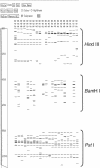Fosmid-based physical mapping of the Histoplasma capsulatum genome
- PMID: 15289478
- PMCID: PMC509269
- DOI: 10.1101/gr.2361404
Fosmid-based physical mapping of the Histoplasma capsulatum genome
Abstract
A fosmid library representing 10-fold coverage of the Histoplasma capsulatum G217B genome was used to construct a restriction-based physical map. The data obtained from three restriction endonuclease fingerprints, generated from each clone using BamHI, HindIII, and PstI endonucleases, were combined and used in FPC for automatic and manual contig assembly builds. Concomitantly, a whole-genome shotgun (WGS) sequencing of paired-end reads from plasmids and fosmids were assembled with PCAP, providing a predicted genome size of up to 43.5 Mbp and 17% repetitive DNA. Fosmid paired-end sequences in the WGS assembly provide anchoring information to the physical map and result in joining of existing physical map contigs into 84 clusters containing 9551 fosmid clones. Here, we detail mapping the Histoplasma capsulatum genome comprehensively in fosmids, resulting in an efficient paradigm for de novo sequencing that uses a map-assisted whole genome shotgun approach.
Copyright 2004 Cold Spring Harbor Laboratory Press ISSN
Figures


Similar articles
-
A physical map of the genome of Atlantic salmon, Salmo salar.Genomics. 2005 Oct;86(4):396-404. doi: 10.1016/j.ygeno.2005.06.001. Genomics. 2005. PMID: 16026963
-
Whole-Genome Restriction Mapping by "Subhaploid"-Based RAD Sequencing: An Efficient and Flexible Approach for Physical Mapping and Genome Scaffolding.Genetics. 2017 Jul;206(3):1237-1250. doi: 10.1534/genetics.117.200303. Epub 2017 May 3. Genetics. 2017. PMID: 28468906 Free PMC article.
-
A BAC-based physical map of the channel catfish genome.Genomics. 2007 Sep;90(3):380-8. doi: 10.1016/j.ygeno.2007.05.008. Epub 2007 Jun 20. Genomics. 2007. PMID: 17582737
-
Chromosome-Level Genome Assembly of a Human Fungal Pathogen Reveals Synteny among Geographically Distinct Species.mBio. 2022 Feb 22;13(1):e0257421. doi: 10.1128/mbio.02574-21. Epub 2022 Jan 4. mBio. 2022. PMID: 35089059 Free PMC article.
-
Paired-end sequencing of Fosmid libraries by Illumina.Genome Res. 2012 Nov;22(11):2241-9. doi: 10.1101/gr.138925.112. Epub 2012 Jul 16. Genome Res. 2012. PMID: 22800726 Free PMC article.
Cited by
-
Decoding the fine-scale structure of a breast cancer genome and transcriptome.Genome Res. 2006 Mar;16(3):394-404. doi: 10.1101/gr.4247306. Epub 2006 Feb 3. Genome Res. 2006. PMID: 16461635 Free PMC article.
-
Fosmid library construction and initial analysis of end sequences in female half-smooth tongue sole (Cynoglossus semilaevis).Mar Biotechnol (NY). 2009 Mar-Apr;11(2):236-42. doi: 10.1007/s10126-008-9137-2. Epub 2008 Sep 2. Mar Biotechnol (NY). 2009. PMID: 18763017
-
Genetic Diversity of Human Fungal Pathogens.Curr Clin Microbiol Rep. 2023 Jun;10(2):17-28. doi: 10.1007/s40588-023-00188-4. Epub 2023 Feb 14. Curr Clin Microbiol Rep. 2023. PMID: 37388463 Free PMC article.
-
Fosmid library construction and initial analysis of end sequences in Zhikong scallop (Chlamys farreri).Mar Biotechnol (NY). 2007 Sep-Oct;9(5):606-12. doi: 10.1007/s10126-007-9014-4. Epub 2007 Jun 29. Mar Biotechnol (NY). 2007. PMID: 17605073
-
Phylogenomic evolutionary surveys of subtilase superfamily genes in fungi.Sci Rep. 2017 Mar 30;7:45456. doi: 10.1038/srep45456. Sci Rep. 2017. PMID: 28358043 Free PMC article.
References
-
- Altschul, S.F., Gish, W., Miller, W., Myers, E.W., and Lipman, D.J. 1990. Basic local alignment search tool. J. Mol. Biol. 215: 403–410. - PubMed
-
- Bradsher, R.W. 1996. Histoplasmosis and blastomycosis. Clin. Infect. Dis. 22 Suppl 2: S102–S11. - PubMed
-
- Carter, D.A., Taylor, J.W., Dechairo, B., Burt, A., Koenig, G.L., and White, T.J. 2001. Amplified single-nucleotide polymorphisms and a (GA)(n) microsatellite marker reveal genetic differentiation between populations of Histoplasma capsulatum from the Americas. Fungal Genet. Biol. 34: 37–48. - PubMed
WEB SITE REFERENCES
-
- http://www.genome.arizona.edu/software/fpc/; The FPC and Friends Web site is associated with the Arizona Genomics Institute (AGI) and Arizona Genomics Computational Laboratory (AGCoL). This site provides FPC software download and documentation links.
-
- http://www.genome.wustl.edu/blast/histo_client.cgi; This link is part of the Histoplasma capsulatum project maintained on the Genome Sequencing Center Web site. The Histoplasma capsulatum G217B and G186A-R Whole Genome Shotgun (WGS) PCAP and ARACHNE assemblies are available for BLASTIN searches.
-
- http://genome.wustl.edu/projects/hcapsulatum/index.php?fpc=1; An additional link where the Histoplasma capsulatum FPC database can be downloaded.
-
- http://www.sanger.ac.uk/Software/Image; A link to IMAGE, the fingerprint image analysis system, at the Sanger Institute.
-
- http://www.tigr.org/tdb/bac_ends/mouse/bac_end_intro.html; This site provides links to BAC End Sequencing Protocols and BAC library resources.
Publication types
MeSH terms
Grants and funding
LinkOut - more resources
Full Text Sources
Other Literature Sources
Miscellaneous
